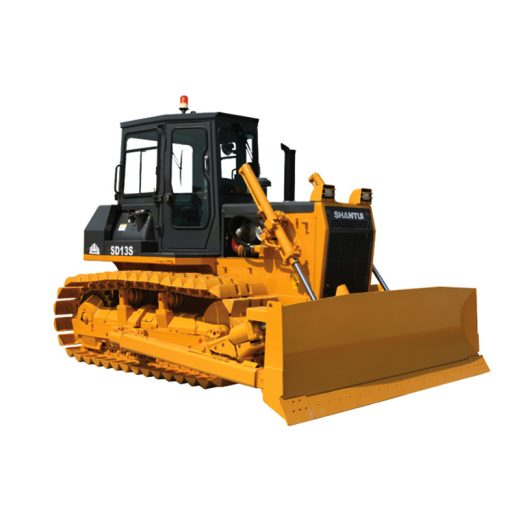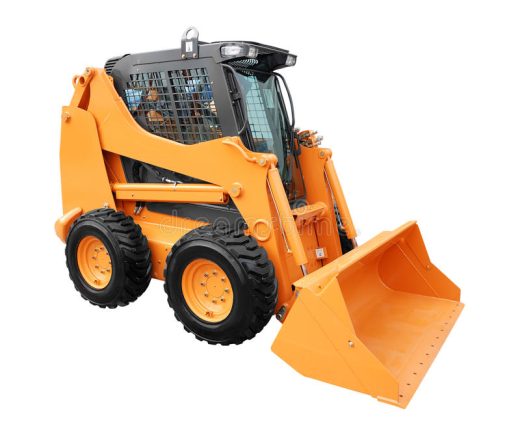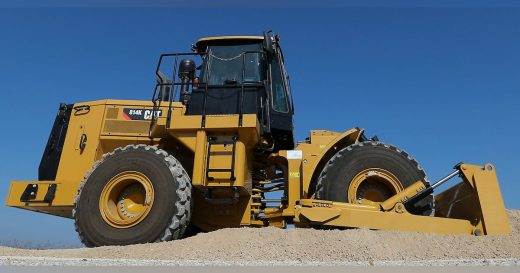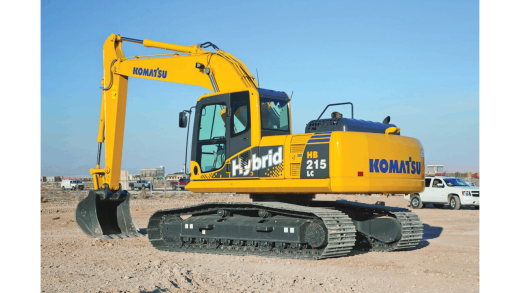Introduction:
Choosing the right machine for the site’s terrain is very important. Before deciding on the equipment, one should consider the available options and how the site is set up. A bulldozer is a large piece of construction equipment used to move large amounts of soil, sand, snow, debris, or other similar materials on a construction site. The name “bulldozer” comes from the fact that it has a dozer blade. It has a metal plate on the front that is used to move bigger loads to their destination. On the back, a device looks like a claw to loosen materials tightly packed together. Bulldozers aren’t just used on construction sites, quarries, military bases, and farms.
What is a Bulldozer?
A bulldozer, an important instrument in the construction industry, features a blade joint to its face, against which mud can be broken up and leaned for easier removal. A bulldozer is a tractor with an excavating blade mounted on the front of the vehicle. The blade can push, shear, cut, or roll materials forward of the tractor. The optimal speed for this earthmover is around 5 kilometers per hour. Adjusting the blade size of a bulldozer can be done within a certain range for each model.
The low center of gravity and wide bulldozer tracks give it excellent grip and stability on grades and other unlevel ground. It improves electricity distribution to the ground. Many different blades and attachments can be used with a dozer. Dozers are adaptable to many job sites because of the accessories at their disposal.
Parts of a Bulldozer:
i) Rippers:
A ripper is a long piece on the back of a bulldozer that looks like a claw. Rippers are used to break up land so crops can grow on it or to break up rocks and earth so they can be moved. Depending on what you need for your project, you can find both single-shank rippers and multi-shank rippers.
ii) Engine:
Most bulldozers have powerful motors because they move a lot of heavy materials around the work site. There are many kinds of motors that meet different needs. For example, newer motors produce less pollution than older ones to meet certain EPA specifications.
iii) Cab:
The operator controls the bulldozer from the cab, which is an important part of the machine. Some taxis have special features that make them safer and more comfortable. Check if your cab reduces noise and absorbs shocks as you move around the job site. Because drivers can be in the cab for hours at a time, these are essential.
iv) Bulldozer Blades:
The bulldozer’s large metal plate, known as the blade, is at the front of the machine and is used to push and dig through various materials. We’ve already established that many blades have their place in the world.
v) Final Drive:
The final drive of a bulldozer is the most often used and replaced component. The load is spread across numerous gear teeth in a modern final drive, and the drive motor is no longer suspended.
vi) Track/ Tyres:
Tracks and tyres greatly affect a bulldozer’s ability to move. Tracks are better for exploring hard, unbalanced ground, while tires are better for soft ground. You may also need to consider tires if you’re working in a sensitive area you don’t want to hurt.
vii) Push Frame:
A push frame is an important tool for setting things in place. For the blade to move, this bulldozer component is essential.
Different Types of Bulldozers:
1. Crawler Bulldozer:
A crawler bulldozer, also known as a tracked bulldozer, is good for jobs that need a lot of pulling power. This heavyweight is great for moving heavy things from one place to another. The tracks on this bulldozer give it a lot of grips so that it can move easily over rough and uneven ground. Larger crawlers have rippers that help crush and clear terrain that is hard to move.
 Fig1: Crawler Bulldozer
Fig1: Crawler Bulldozer
Courtesy: evangelchina.en.made-in-china.com
2. Mini Bulldozer:
 Fig2: Mini Bulldozer
Fig2: Mini Bulldozer
Courtesy: dreamstime.com
Mini bulldozers, also known as compact bulldozers, are more flexible and versatile than larger machines and are ideal for various applications. The newer micro dozers are more technologically advanced and have an engine that produces fewer emissions and uses less gasoline. With its redesigned, downwardly sloping hood line, it’s easier to see the blade’s cutting edge and other nearby objects, leading to greater productivity in the final polishing stages. Mini bulldozers’ slope assists function and increase productivity by orienting the chassis perpendicular to the slope. It works in tandem with the operator’s input on the blade controls to make grading simpler, quicker, and less taxing on the body.
3. Wheel Bulldozer:
 Fig3: Wheel Bulldozer
Fig3: Wheel Bulldozer
Courtesy: constructionequipment.com
This machine is usually bigger than a crawler and is also called a tyre bulldozer. Wheel bulldozers have strong frames that can last long and withstand the roughest conditions. It has a full box-section rear frame that can handle twisting forces and shocks. The way the axle is mounted is optimized to make the structure stronger. Now, the models come with a Steering and Transmission Integrated Control System, which combines the controls for steering, changing gears, and going in a certain direction into a single lever.
The newest wheel dozers have a mechanically activated electronic unit-injection system, engine-idle-shutdown and engine-idle kick-down systems and a hydraulically powered cooling fan that only turns on when needed. The operator cab has automatic temperature control, a touch-screen display with a soft keypad, an electric/hydraulic parking brake, and a Comfort III seat with air-ride suspension and built-in controls.
4. Hybrid Bulldozer:
 Fig4: Hybrid Bulldozer
Fig4: Hybrid Bulldozer
Courtesy: forconstructionpros.com
Hybrid bulldozers are high-tech machines that use electronic parts and have a combination of blades that can work in both wet and very hard conditions simultaneously. Today, we have bulldozers that can work in swampy and muddy conditions. We also have custom blades that can be put on any vehicle, like a tractor, all-terrain vehicle, or skid steer.
Types of Blades used in bulldozer:
Different blades are used for different situations, can cut different kinds of materials, and can carry a variety of load weights. The following are the most popular types of blades used in bulldozers.”
i) Straight Blades (S-Blades):
A bulldozer’s most restricted edge, an S-sharp edge, lacks the side wings of other types of edges. Lower back corners of this cutting edge attached to the arm. The straight sharp edge excels in fine-grained and medium-to-hard thicknesses due to its form. However, the dozer’s lifting and transporting capacities are limited due to its straightforward design. Solving puzzles, restocking, appraising, and evening soil are the best uses for s-edges.
ii) Semi-Universal Blades(S-U Blades):
It’s a different type of bulldozer blade that combines straight-blade and universal blades. It will be thin and shapeless, and the feathers on its sides will be softer than those on the universal blade. The build reduces loss and improves the bulldozer’s ability to move dirt. It can even move mud to higher heights. With edge-holding braces, the semi-universal blade will connect to the lumbar region of the blade. It spreads sound well and is very skillful. Bulldozers can be used for infilling, explosion, junk, final, despoil, and clumping claims like blades.
iii) Universal Blades (U- Blades):
A U-blade has big side wings and a curved shape that make it perfect for pushing things across long stretches of land. The wings keep things from falling out when the box is in motion. Like S-Blades, they attach to the blade’s lower back corners. It has the tallest and widest blades and works best with soft to medium-density soil. U-blades are best for ditching, hauling, pushing, and crowning.
iv) Angle- Blade:
This blade is attached to the bulldozer in the middle of the panel. It is great for moving trash to the side because it can tilt about 30 degrees left or right. So, a blade with an angle is called a two-way blade. Because it lacks side wings, this blade may bleed. Work can be done easily in soft to medium-hard soils, snow, or gravel conditions. Angle blades excel at stumping, shaping, stripping, and ditching.
v) Power-Angle-Tilt Blade:
This blade type is mostly used for bulldozers and can control the whole tilt edge. The driver can use an opener to build these cabins. The blades have 4, 6, or 8 paths and are climbed in the middle of the dashboard. There are fewer giveaway problems. They can keep reloading, razing, handing out, praising, and sorting.
How to Choose the Right Bulldozer?
You must be able to choose the appropriate bulldozer if you are aware that you require one of these tools for your work. You can choose the model, size, attachments, and purchasing or renting alternatives that are best for you by considering a few factors:
- The right dozer is about more than just the equipment you require. It would be best to consider the equipment’s cost and budget. It helps you determine whether to lease or buy new or old equipment. Calculate the cost of extra features and attachments.
- Bulldozers are used in a wide range of industries. What you will use the bulldozer for will determine its size and attachments.
- Each project has various needs. Likewise, each location’s size and layout can provide distinct obstacles. You want a machine that’s manageable for your site and too tiny to complete the job.
- Site safety is important for both large and small projects. To keep yourself and your workers safe, you need to know how Bulldozers and their attachments work and what standards they should meet.
- You’ll need to refill, lubricate, and service your dozer often, possibly daily. Machine and work dictate maintenance schedule. Whether you lease or buy a bulldozer, learn how to maintain it.
Uses of Bulldozers:
- Most of the time, bulldozers are used to destroy buildings.
- Bulldozers are also used for earthwork. The front blade of the machine pushes up dirt, soil, sand, etc.
- Bulldozers can also be used in construction projects and to clear land. Before a construction dig or build can start, it’s common for the area’s brush and natural plants to need to be cleared away. Bulldozers take care of this job in one fell swoop.
- They clear away unwanted trees, bushes, and sometimes garbage and other trash if the land needs to be better managed.
- A bulldozer can build roads and pavement. As with a construction site, a road must be cleared and leveled before paving or covering can begin.
Conclusion:
Bulldozers are powerful machines used primarily to push, dig, excavate, and level materials like soil and waste at a construction site. The front of these machines is equipped with big, hefty blades that can push through various materials. Some versions have special equipment, like rear rippers, to help them navigate difficult terrain.
Today, the bulldozer is used for many tasks and is an important part of many projects. Because of their size, strength, and power are the best tools for any demolition or earth-moving job. Bulldozers are often used in digging, mining, farming, and road work.
Conclusion:
1. BigRentz. “Bulldozer Types, Parts and Their Uses | BigRentz.” Bulldozer Types, Parts and Their Uses | BigRentz, 12 June 2019, www.bigrentz.com/blog/bulldozer-
types#:~:text=Bulldozers%20are%20strong%20machines%20that,help%20break%20down%20tough%20ground.
2. admin. “Types of Bulldozers and Bulldozer Blades – With Explained [Uses, Parts and Function].” Engineering Learn, 11 Jan. 2022, engineeringlearn.com/types-of-bulldozers-and-bulldozer-blades-with-explained-uses-parts-function.
3. Muth, Reannon. “The 3 Most Common Types of Dozers.” The 3 Most Common Types of Dozers | News | Heavy Metal Equipment & Rentals, 14 Oct. 2019, www.heavyequipmentrentals.com/about/news/types-of-dozers.
4. “Different Types of Dozers and Blades Used in Construction.” Constro Facilitator, 21 July 2021, constrofacilitator.com/different-types-of-dozers-and-blades-used-in-construction.
5. Colleges of America, Heavy Equipment. “Bulldozer Types and Their Applications: A Complete Guide of Dozer.” Heavy Equipment Colleges of America, 12 Oct. 2020, heavyequipmentcollege.com/bulldozer-types-applications-complete-guide.
6. Quinn. “How to Choose the Right Dozer for Your Job | Quinn Company.” Quinn Company, 21 July 2020, www.quinncompany.com/how-to-choose-the-right-dozer-for-your-job.
If you have a query, you can ask a question here.


